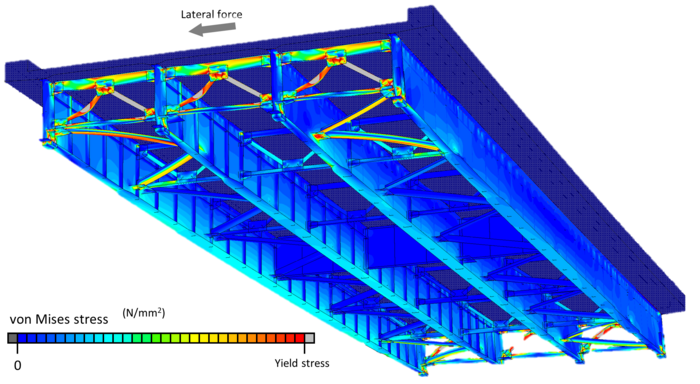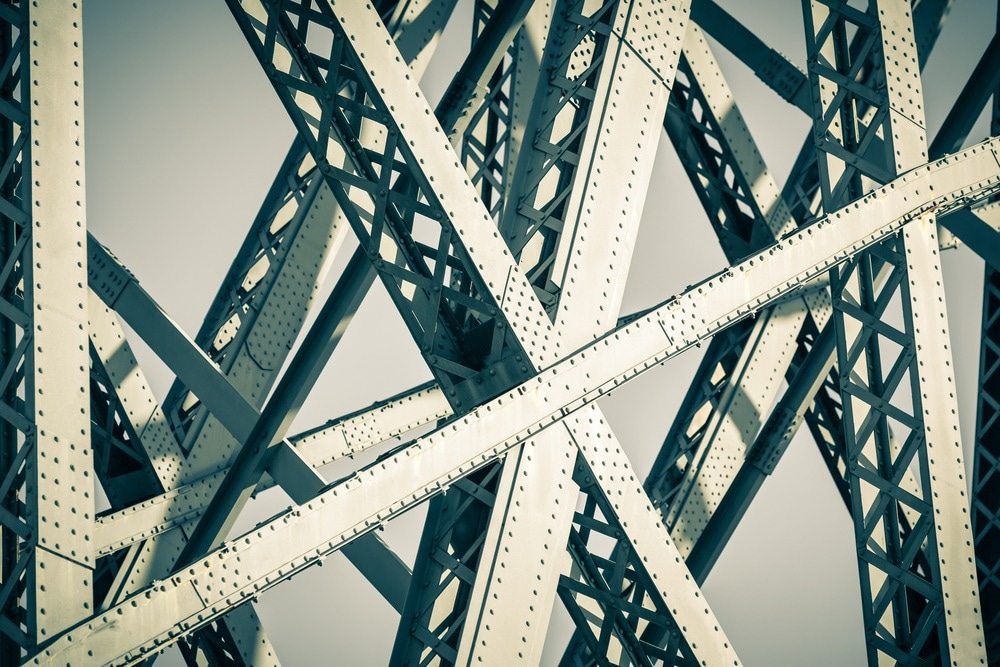Reviewed by Alex SmithDec 5 2022
Tokyo Metropolitan University scientists conducted a comprehensive simulation of how a popular type of bridge fails during major earthquakes. They examined the step-by-step method by which “I-shaped girder” bridges buckle and deform under lateral forces, beginning at the ends.

Local stress in the bridge structure just as lateral displacements get drastically large (deformations have been magnified five times). Image Credit: Tokyo Metropolitan University.
Reinforcing ribs have been demonstrated to be beneficial against lateral forces and to enhance load-bearing capacity.
Large earthquakes can be catastrophic to infrastructure. The consequences of a badly damaged bridge, for instance, extend beyond the tragedy that occurs on it to how the loss of access impacts emergency services, evacuation operations, and the transport of critical supplies.
Determining how seismic activity affects typical bridge structures is therefore critical, not only for building robust quake-resistant bridges but also for preventing the breakdown of existing ones by appropriate reinforcement. Though numerical models persist to assess the durability of bridge superstructures, there are few examples that examine how each component of the entire bridge structure responds during large-scale earthquakes.
A group headed by Tokyo Metropolitan University’s Professor Jun Murakoshi has been exploring precise models that correctly reflect the real behavior of complete structures, with an emphasis on how they might inform new design concepts.
 Image Credit: dvoevnore/Shutterstock.com
Image Credit: dvoevnore/Shutterstock.com
They investigated the failure process and the effect on load-bearing capacity caused by lateral shaking of an “I-shaped girder” bridge, a popular bridge type with a span length of 30 m; supported steel girders shaped to resemble a capital “I” carry a flat “deck slab” over which cars and people can pass. Researchers exposed their model bridge to the lateral forces experienced during earthquakes, taking into account the response when the force was delivered to the girders in the longitudinal and transverse directions.
The model provided a precise representation of how the bridge yields and deforms. For instance, when a force was applied in a transverse direction, the lower portion of the vertical stiffeners on the support was the first area to be impacted, then the diagonal members of the end cross frame began to yield.
The vertical stiffeners continue to yield until the gusset plate (a steel plate that links the lateral members) begins to deform. Though this does not result in bridge failure, there have already been reports of deformations obstructing the passage of rescue vehicles following large-scale earthquakes.
The question that persists now is: How is it possible to stop this from happening? The team then investigated the impact of reinforcing ribs on the structure: a model with reinforcing ribs demonstrated how stress acting on the girders and the end cross frame connecting them may be decreased.
As a result, the group’s work offers rational insight into how bridge structures might be constructed and reinforced to make the infrastructure safer, as well as improved ways of assessing their safety.
The Japan Iron and Steel Federation provided funding for this project.
Journal Reference:
Katayama, T., et al. (2022) Damage Mechanism and Load-Carrying Capacity at Girder End of Existing Steel Girder Bridge Under Seismic Lateral Force. International Journal of Steel Structures. doi.org/10.1007/s13296-022-00672-5.